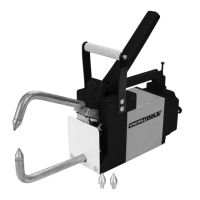UNPACKING
After unpacking the unit, inspect carefully for any damage that
may have occurred during transit. Check for loose, missing,
or damaged parts. If any damage is observed, a shipping
damage claim must be filed with the carrier. DO NOT use the
OEMTOOLS
™
24819 120V Spot Welder if broken, bent, cracked
or damaged parts (including labels) are noted. Any Spot Welder
that appears damaged in any way, operates abnormally or is
missing parts should be removed from service immediately. If
you suspect that the Spot Welder was subjected to shock load
(a load that was dropped suddenly, unexpectedly, etc.),
immediately discontinue use until it has been checked by a
factory authorized service center.
Operating Instructions and Parts Manual 24819
120V SPOT WELDER
2/18
2018 OEMTOOLS
™
Thank you very much for choosing an OEMTOOLS
™
Product!
For future reference, please register your new product at www.oem-tools.com and complete the owner’s record below:
Model: _______________ Purchase Date: ___________
Save the receipt, warranty and these instructions. It is important that you read the entire manual to become familiar with this product
before you begin using it. This product is designed for certain applications only. OEMTOOLS
™
cannot be responsible for issues arising
from modification. We strongly recommend this product is not modified and/or used for any application other than that for which it was
designed. If you have any questions relative to a particular application, DO NOT use the product until you have first contacted customer
service to determine if it can or should be performed on the product.
The following safety information is provided as a guideline to help you operate your Spot Welder under the safest possible conditions. Any
tool or piece of equipment can be potentially dangerous to use when safety or safe handling instructions are not known or not followed.
The following safety instructions are to provide the user with the information necessary for safe use and operation. Please read and retain
these instructions for the continued safe use of your Spot Welder. Failure to follow instructions listed below may result in serious injury. In
addition, make sure that anyone who uses the equipment understands and follows these safety instructions as well.
WARNING
WARNING: Indicates a potentially hazardous situation which, if not avoided, could result in death or serious injury.
CAUTION: Indicates a potentially hazardous situation which, if not avoided, may result in minor or moderate injury.
CAUTION: Used without the safety alert symbol indicates a potentially hazardous situation which, if not avoided, may
result in property damage.
NOTES: Provide clarity and helpful information.
Explanation of Safety Signal Words
Please read and save these instructions. Read through this owner’s manual carefully before using product. Protect
yourself and others by observing all safety information, warnings, and cautions. Failure to comply with instructions
could result in personal injury and/or damage to product or property. Please retain instructions for future reference.
FOR CUSTOMER SERVICE
Technical Question?
CALL 1-866-458-2472
customerservice@oem-tools.com

